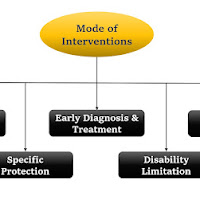Modes of Intervention
“Intervention” can be defined as any attempt to intervene or interrupt the usual sequence in the development of disease in man. This may be by the provision of treatment, education, health or social support. Five modes of intervention have been described. These levels are related to agent, host and environment.
They are-
1. Health promotion
2. Specific protection
3. Early diagnosis and treatment
4. Disability limitation
5. Rehabilitation
 |
| Modes of Interventions |
1. Health promotion:
Health promotion is “the process of enabling people to increase control over and to improve health”. It is not directed against any particular disease. The well-known interventions in this area are-
i) Health education
ii) Environmental modification
iii) Nutritional interventions
iv) Lifestyle and behavior changes
i) Health education:-
The target for educational efforts may include the general public, patient, priority groups, health providers, community leaders and decision makers.
ii) Environmental modification:-
A comprehensive approach to health promotion requires environmental modifications, such as provision of safe water, installation of sanitary latrines, control of insect, improvement of housing etc. Environmental interventions are non clinical and do not involve the physicians.
iii) Nutritional intervention:-
These comprise food distribution and nutrition improvement of poor groups; child feeding programs; food fortification; nutrition education etc.
iv) Lifestyle and behavior changes:-
The action of prevention in this case, is one of of individual and community responsibility for health.
2. Specific protection:
The following are some of the currently available interventions aimed at specific protection-
 |
| Specific Protection |
3. Early diagnosis and treatment:
Early detection and treatment are the main interventions of disease control. Early diagnosis and treatment through not as effective and economical as “primary prevention” may be critically important in reducing the high morbidity or mortality in certain disease such as essential hypertension, cancer cervix and breast cancer.
4. Disability limitation:
The WHO has defined these terms as follows-
i) Impairment:-
An impairment is defined as “any loss or or abnormality of psychological, physiological, or anatomical structure or function”. e.g., loss of foot
ii) Disability:-
Because of impairment, the affected person may be unable to carry out certain activities considered normal for his age, sex etc.
iii) Handicap:-
This is term “handicap”, and is defined as “a advantage for given individuals, resulting from an impairment or disability”.
 |
| Example of disability limitation |
5. Rehabilitation:
Rehabilitation has been defined as- “the combined and coordinated use of medical, social, educational and vocational measures for training and retraining the individuals to the highest possible level of functional ability.
It involves disciplines such as physical medicine or physiotherapy, occupational therapy, speech therapy, psychology, audiology, education, social work, vocational guidance and placement services.
The following areas of concern in rehabilitation have been identified:
1. Medical Rehabilitation:- Restoration of function.
2. Vocational Rehabilitation:- Restoration of the capacity to earn a livelihood.
3. Social Rehabilitation:- Restoration of family and social relationship.
4. Phychological Rehabilitation:- Restoration of personal dignity and confidence.
Example of rehabilitation are: establishing schools for the blind, provision of aids for the crippled, reconstructive surgery in leprosy, muscle re-education and graded exercise in neurological disorder like polio.
It is now recognized that rehabilitation is a difficult and demanding tasks. It is further recognized that interventions at earlier stages are more feasible.
 |
| Rehabilitation |
Read More:

